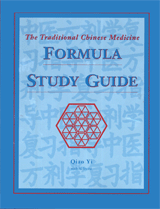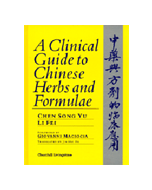We use cookies to make your experience better. To comply with the new e-Privacy directive, we need to ask for your consent to set the cookies. Learn more.
The Traditional Chinese Medicine Formula Study Guide
Tailored specifically to coach students for the NCCA exam, the California State Board Exam, and similar accreditation examinations, this book is a concise and practical study text on 130 formulas arranged by category (heat-clearing, dampness-dispelling, etc). Each category includes a general introduction to the syndrome (definition, characteristics, etiology, classification, and symptoms) and numerous visually useful tables that provide details of formula differentiation and discrimination by symptom, characteristic, and diagnostic evidence, along with treatment principle.
The information on each formula includes the individual herb functions, allowing a quick overview of the formula's interrelated functions. The accompanying formula comparison charts help clarify treatment aims, as well as differences between similar formulas. Each chapter reviews the formulas in that section with self-exam questions and answers, along with detailed discussions. This study manual also includes symptom differentiation charts that allow easy clinical reference to assist with accurate formula selection. They are based on differentiation according to the zang fu and six-stage syndromes. The final comprehensive exam allows students to self-test their knowledge of the formulas themselves and their clinical applications through formula and case study questions.
This is a finely conceived and executed study guide to 130 principal Chinese herbal medicine formulas. It does not seek to replace a reference text such as Eastland's Formulas & Strategies, to which the publishers pay tribute, but is aimed very accurately at the needs of students. The book is divided into four parts. The first, and briefest, covers the essential principles of Chinese herbal medicine such as herb actions and tastes, decoction methods, the seven combining effects of herbs, the fifteen incompatible herb relationships etc. Part two is devoted to the formulas, grouped in conventional categories such as harmonising, expelling damp etc. The category chapter begins with a general introduction explaining the kind of patterns likely to be encountered. For each formula ingredients (pinyin followed by latin) are listed and their individual or combined action explained, then the functions and indications. A cautions/contraindications section adds valuable information. For example for Xiao Chai Hu Tang "It is important to inform patients with upright Qi deficiency about the possibility of healing reactions occurring while taking this prescription. Possible symptoms include feverishness, shivers and sweating". Especially valuable are the many chart format formula comparisons, for example in the harmonising chapter, Si Ni San is compared to Si Ni Tang, Xiao Yao San to Si Ni San and to Xiao Chai Hu Tang etc. These charts show both common and different ingredients, functions and symptoms, and compare and contrast tongue colour, pulse and therapeutic emphasis. Each category chapter ends with a brief review of the formulas in that category and a series of study questions with answers, for example "Why are Chai Hu and Huang Qin used together in Xiao Chai Hu Tang?". The third part of the book comprises reference charts to differentiation of 23 main symptoms such as abdominal pain, cough, diarrhoea etc. Each describes the principal patterns likely to be encountered, the main symptoms of each and the suitable formula for treatment. The final part of the book is in the form of a comprehensive examination with several hundred questions on formulas and case studies.
This is a really valuable aid to studying formulas. It does not attempt to replace a major formula textbook, for example only 130 formulas are covered, there are no modifications (i.e the addition and subtraction of herbs to treat different presentations) etc., but it will really help students to deepen and solidify their knowledge of the basic formulas.
Classification of the Formulas by Treatment Categories
Acknowledgements
Making Best Use of this Book
Introduction: The Essential Principles of Chinese Herbal Medicine
Herb Actions Based on the Nature of Plant Parts and Tastes
Special Methods of Decocting Chinese Herbs
The Seven Combining Effects of Herbs
Incompatible and Antagonistic Herbs
The Principles of Formula Writing
The Eight Methods of Herbal Treatment
Chapter I Formulas to Release the Exterior
Introduction to Exterior Syndromes
The Formulas
Review and Discussion
Chapter 2 Formulas to Clear Heat
Introduction to Heat Syndromes
The Formulas
Review and Discussion
Chapter 3 Formulas to Purge
Introduction to Yang Ming Organ Syndromes
The Formulas
Review and Discussion
Cbapter 4 Formulas to Harrnonize
Introduction to Shao Yang Syndromes
The Formulas
Review and Discussion
Chapter 5 Formulas to Expel Damp
Introduction to Damp Syndromes
The Formulas
Review and Discussion
Chapter 6 Formulas to Resolve Phlegm
Introduction to Phlegm Syndromes
The Formulas
Review and Discussion
Chapter 7 Formulas to Warm the Interior
Introduction to Cold Syndromes
The Formulas
Review and Discussion
Chapter 8 Formulas to Tonify
Introduction to Deficiency Syndromes
The Formulas
Review and Discussion
Chapter 9 Formulas to Regulate the Qi
Introduction to Qi Dysfunction Syndromes
The Formulas
Review and Discussion
Chapter 10 Formulas to Invigorate the Blood
Introduction to Blood Stagnation Syndromes
The Formulas
Review and Discussion
Chapter 11 Formulas to Stop Bleeding
Introduction to Bleeding Syndromes
The Formulas
Review and Discussion
Chapter 12 Formulas to Stabilize and Astringe
Introduction to Leakage and Discharge Syndromes
The Formulas
Review and Discussion
Chapter 13 Formulas to Calrn the Mind
Introduction to Mind Disharmony Syndromes
The Formulas
Review and Discussion
Chapter 14 Formulas to Expel Wind
Introduction to Wind Syndromes
The Formulas
Review and Discussion
Chapter 15 Formulas to Reduce Food Stagnation
Introduction to Food Stagnation Syndromes
The Formulas
Review and Discussion
Symptom Differentiation Charts
Abdominal Pain
Cough
Diarrhea
Dizziness and Vertigo
Edema
Emotional Conditions
Epigastric Pain
Fatigue
Fever, Low-Grade
Fever, Tidal
Headache
Hypochondriac Pain
Insomnia
Memory Loss
Menstrual Disorders
Nausea and Vomiting
Palpitations
Sweating Syndrome: Spontaneous Sweating
Sweating Syndrome: Night Sweats
Sweating Syndrome: Sweating by Location
Tinnitus and Deafness
Urinary Pain
Wheezing and Breathlessness
Comprehensive Examination
Primary Formula Questions
General Formula Questions
Case Study Questions
Answers to the Primary Formula Question
Answers to the General Formula Questions
Answers to the Case Study Questions
Bibliography
Index
| Summary | Qiao Yi with Al Stone Snow Lotus Press, 2000 360 pages Paperback |
|---|---|
| Author | Qiao Yi with Al Stone |
| Publication Date | 1 Jan 1970 |
| Publisher | Snow Lotus Press |
| Number of Pages | 360 |
| Book Format | Softback |
* Orders shipped outside of Europe are eligible for VAT relief and will not be charged VAT.




